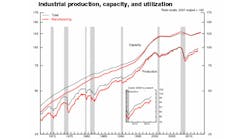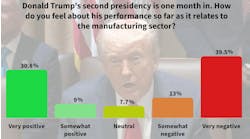U.S. industrial production rose 0.4% in March, largely on the strength of increased utilities output arising from a cold winter that drove up heating demand, the Federal Reserve reported today. For the first quarter of 2013, production moved up at an annual rate of 5.0%.
Manufacturing output declined by 0.1% in March, but rose at an annual rate of 5.3% for the quarter. Capacity utilization also moved down in March, declining 0.2% to 76.4%. That is 12.4% higher than the recession’s trough in June 2009 but 2.3% lower than the long-term average.
Noting the strong growth in the first quarter, Dan Meckstroth, chief economist for the Manufacturers Alliance for Productivity and Innovation (MAPI), said: “We have seen this pattern for the last couple of years, where production surges in the first quarter and then is followed by a lull as excessive inventories adjust. MAPI believes that manufacturing production activity is repeating this pattern again in 2013. Consumers are income-constrained (from slow wage growth and higher payroll taxes), businesses are cautious, exports are weak, and government is in full austerity mode. It still looks like only modest growth is possible in 2013.”
The output of durable goods dropped 0.2% in March after climbing 1.6% in February. The Fed reported decreases of more than 1% in the indexes for primary metals and for electrical equipment, appliance and components. However, motor vehicles and parts had a strong 2.9% gain in March, while machinery registered a 0.3% increase.
Nondurable manufacturing showed no change in March. Increases in textile and product mills, chemicals and printing and support were offset by declines in other nondurable goods, including paper and apparel and leather products.




